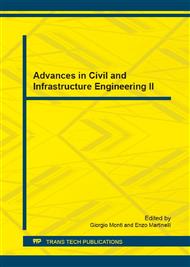[1]
S.K. Verma, S.S. Bhadauria, S. Akhtar, Probabilistic Evaluation of Service Life for Reinforced Concrete Structures, Chinese Journal of Engineering, article ID 648438, (2014).
DOI: 10.1155/2014/648438
Google Scholar
[2]
F. Biondini, D.M. Frangopol, Probabilistic limit analysis and lifetime prediction of concrete structures, Structural and Infrastructural Engineering, Vol. 4 No. 5, 2008, pp.399-412.
DOI: 10.1080/15732470701270157
Google Scholar
[3]
F. Biondini, M. Vergani, Damage modeling and nonlinear analysis of concrete bridges under corrosion, Proceedings of the 6th IABMAS 2012, Stresa, Italy, 2012, in: Bridge Maintenance, Safety, Management, Resilience and Sustainability, F. Biondini, D.M. Frangopol, (Eds. ), CRC Press, Taylor and Francis Group.
DOI: 10.1201/b12352-132
Google Scholar
[4]
DuraCrete, Modelling of Degradation, EU-Project No. BE95-1347, Probabilistic Performance based Durability Design of Concrete Structures, Report 4-5, (1998).
Google Scholar
[5]
CEB-FIB Task Group 5. 6, Model Code for service life design, Fédération Internationale du Béton FIB, Bulletin 31, (2006).
Google Scholar
[6]
O. Ditlevsen, H.O. Madsen, Structural Reliability Methods, Maritime Engineering, Department of Mechanical Engineering, Technical University of Denmark, (2004).
Google Scholar
[7]
EN 1990(2002): Eurocode 0 - Basis of Structural Design, (2002).
Google Scholar
[8]
M. Collepardi, S. Collepardi, J.J. Ogoumah Olagot, F. Simonelli, R. Trioli, Diagnosi del degrado e restauro delle strutture in c. a., Tintoretto, (2010).
Google Scholar
[9]
K. Tuutti, Corrosion of steel in concrete, Swedish Cement and Concrete Research Institute, Stockholm, Sweden, Report 4, (1982).
Google Scholar
[10]
Y. Liu, R. Weyers, Modeling the Time-to-Corrosion Cracking in chloride contaminated reinforced concrete structures, ACI Materials Journal, Vol. 95, (1998).
DOI: 10.14359/410
Google Scholar
[11]
D.V. Val, M.G. Stewart, R.E. Melchers, Effect of reinforcement corrosion on reliability of highway bridges, Engineering Structures, Vol. 20 No. 11, 1998, pp.1010-1019.
DOI: 10.1016/s0141-0296(97)00197-1
Google Scholar
[12]
D. Coronelli, P. Gambarova, Structural assessment of corroded reinforced concrete beams: modeling guidelines, Journal of Structural Engineering, Vol. 130, No. 8, 2004, pp.1214-1224.
DOI: 10.1061/(asce)0733-9445(2004)130:8(1214)
Google Scholar
[13]
L.P. Saenz, Discussion of a paper by P. Desayi and S. Krishnan, Equation for the Stress-Strain Curve of Concrete, ACI Journal, Vol. 61, No. 9, 1964, pp.1229-1235.
Google Scholar
[14]
D.C. Kent, R. Park, Flexural members with confined concrete, Journal of the Structural Division, Vol. 97, No. 7, 1971, p.1969-(1990).
DOI: 10.1061/jsdeag.0002957
Google Scholar
[15]
Norme Tecniche per le Costruzioni, D.M. 14 Gennaio, (2008).
Google Scholar
[16]
H. Okamura, K. Maekawa, S. Sivasubramaniyam, Verification of Modeling for reinforced concrete finite element, in: Finite Element Analysis of Reinforced Concrete Structures, proceedings of the Seminar ASCE 1985, pp.528-543.
DOI: 10.14359/11643
Google Scholar
[17]
H. Hwang, J.B. Liu, Y.H. Chiu, Seismic Fragility Analysis of Highway Bridges, Mid-America Earthquake Center, Technical Report, MAEC RR-4 Project, Center for Earthquake Research and Information, The University of Memphis, Report, (2001).
Google Scholar
[18]
UNI EN 206-1: Specificazione, prestazione, produzione e conformità, (2006).
Google Scholar
[19]
Information on http: /www. usclimatedata. com.
Google Scholar
[20]
S.D. Fotopolulou, S.T. Karapetrou, K.D. Pitilakis, Seismic vulnerability of RC buildings considering SSI and aging effects, 15th World Conference on Earthquake Engineering, Lisbon, Portugal, (2012).
DOI: 10.7712/120113.4800.c1373
Google Scholar
[21]
D.E. Choe, P. Gardoni, D. Rosowsky, T. Haukaas, Seismic fragility estimates for r. c. bridges subject to corrosion, Structural Safety, Vol. 31, 2009, pp.275-283.
DOI: 10.1016/j.strusafe.2008.10.001
Google Scholar
[22]
B. Ellingwood, J.G. MacGregor, T.V. Galambos, C.A. Cornell, Probability-Based Load Criteria: Load Factors and Load Combinations, Journal of the Structural Division, Vol. 108(ST5), 1982, pp.978-997.
DOI: 10.1061/jsdeag.0005959
Google Scholar


